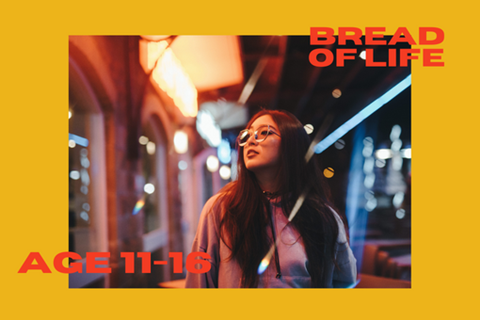
To download as PDF, click here.
Bible passage: John 6:1-15; 22-59
Background: This is a well-known story, but the meaning behind Jesus’ miracle and what he says about himself requires a little more thought. If young people have grown up in church, they are probably familiar with the miracle, so invite them to approach it as if they had never heard it before. If you have young people with little or no church background, work with their surprise at what Jesus does and says, and invite them to respond honestly. A mixture of church experience will help those who have heard this story before to encounter it afresh!
GATHERING TIME
5 minutes
You will need: refreshments; a comfortable place to sit and chat
As the young people arrive, serve them the refreshments you have provided. While you eat and drink together, chat about the young people’s lives. Do they have anything to share? Any triumphs? Any disasters? Share stories from your own life, if appropriate.
FOOD GAMES
10 minutes
You will need: marshmallows; bin; wet wipes; aprons; marmalade; bread; plates; butter knives (or similar)
Play some ‘food games’ with the group. Be aware of food allergies before playing, and always keep a close eye on the participants. Safety is paramount.
Chubby bunnies: the aim is for a player to put as many marshmallows in their mouth as they can, but still clearly say “chubby bunnies” after each one. Keep a bin handy for people to spit their marshmallows into!
Marmalade sandwich: divide the young people into pairs. One puts on an apron and stands in front of a table with a plate, knife, two slices of bread and some marmalade. This person puts their hands behind their back and their partner puts their arms through the first’s armholes. Like this, the partner (standing behind) has to make a sandwich and feed it to their friend in the apron.
BIBLE EXPLORATION
10 minutes
You will need: Bibles; copies of the infographic
Give out the Bibles and copies of the infographic. Read the story together, then give the young people time to match the information in the graphic to the story. Chat together about what they find most interesting about the facts and figures. Has this information helped them understand the story more clearly?
Go on to act out the story. Give the group as much freedom as you can to do this the way they want. With a younger or less confident group, you might want to have some ideas to help them along (act out the story while someone reads it from the Bible; do it all through mime; create a series of tableaux that tell the story). If you have a large number of young people, you could do this in smaller groups.
Perform the story, then chat about how they found it. Discuss how the infographic and the drama aided understanding of the story. Talk about what Jesus might be saying.
CHATTING TOGETHER
10 minutes
Chat about the story using these questions, encouraging everyone to join in if they want to:
- Can you see yourself in the story? Who are you? A disciple? The boy? One of the crowd?
- What does Jesus mean when he said: “I am the bread of life”?
- What does this mean for you in your life?
- What do you want to say to Jesus in response to what you’ve discovered?
CREATIVE RESPONSE
10 minutes
You will need: Bible; bread; grape juice (or similar red juice); plate; cups
Bread is a significant symbol in the Bible, with Jesus taking the bread from Passover and giving it new significance.
If you wish, read 1 Corinthians 11:23- 26 to help the young people imagine this. Chat for a moment about what is happening here. What questions do the young people have about it?
Prepare some bread and a drink for your group. Pass the bread and drink around the group, with each member passing to one another, just like those on the mountainside.
Invite the group to eat the bread and drink. As they do, ask them to think about the Bible passage and Jesus’ words. Read John 6:47-51 to the group and wonder together about what Jesus meant when he said these words. Can the young people identify something new they have discovered? Or something that God has said to them during the session?
Depending on your church tradition, you might need to make it clear that you’re not celebrating Communion, but using the bread and red juice as a way of reflecting on the significance of what Jesus is saying here.
PRAYER
5 minutes
You will need: pencils and paper; basket
Ask the young people to draw the outline of a loaf of bread or fish on some paper.
In a moment or two of silence, ask them to think about knowing Jesus, and how Jesus offered his life.
Invite the group to write a prayer in the outline. The prayer can be words, or it can be a drawing if it is personal (or if they prefer visual to written communication). The prayer can be one of praise and adoration, a confession, something to be thankful for, or a call for help, either for themselves or someone they know.
Once the prayers have been written or drawn, collect them in a basket, just as the food was collected after the miracle.
At the end of the session, the young people can collect their prayers and take them with them as a sign that Jesus will remain with them. Or they could take someone else’s prayer and pray for that during the week. If you do this, make sure no one’s bread or fish is left in the basket at the end.
Supporting documents
Click link to download and view these files898336.pdf
PDF, Size 0.33 mb898491.pdf
PDF, Size 1.22 mb




























